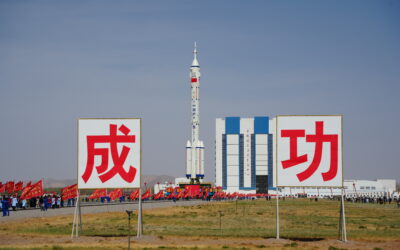
The Long Arm of China’s Security Services
SUBSCRIBER+ EXCLUSIVE REPORTING — When Chinese President Xi Jinping came to San Francisco last November to meet with President Joe Biden, Chinese pro-democracy activists in […] More
OPINION — Like many Americans who came of age in the 1980s, I have lasting childhood memories of the Space Shuttle program. The Shuttle program was a source of national pride. Designed and manufactured in the United States, the Shuttles represented the ingenuity of our country, and they served as a beacon of hope, strength, dedication to purpose, and, of course, innovation. It was only as a young adult when I came to understand the impetus of the Space Shuttle program – the U.S. Government accelerating the race to space against the Soviet Union through continued innovation.
I saw this mission imperative again when I worked in the Central Intelligence Agency’s Directorate of Operations, focusing on counterterrorism in a post-9/11 world. Reeling from the devastating attacks against our homeland, the CIA was driving a mission to identify and eliminate terrorists on a global scale. In pursuit of this mission, paradigms were shifted. Partnerships – domestic and foreign – were born, and tradecraft used by intelligence collectors was transformed.
This became the CIA’s primary focus for the next fifteen years and generations of officers were recruited, trained, and deployed overseas under this mandate. This crisis and resulting mission defined the CIA for many years. The CIA – and the entire Intelligence Community (IC) – expended all resources in this national promise to defeat terrorism. Over time, institutional barriers were overcome. A steadfast commitment to purpose resulted in alliances being built and relationships being formed. Underpinning all this was wide scale innovation in the development and use of specific technologies that very much enabled operations – lethal and otherwise.
As the CIA and the IC were focused on terrorism, the world was changing.
We are engaged in a different fight now. Many of the IC’s tried and true techniques for dealing with terrorist threats are not applicable against nation state actors. Much of what we did in our counterterrorism fight in terms of innovation and the development of technology was started in-house in the USG, within CIA and the IC. Working behind government walls without direct and constant private sector innovation is no longer enough.
As Americans living in 2023, we are of course familiar with the existential threat presented by China. So too has Russia re-emerged as a strategic foe. These nation state threats are immensely challenging. Although we can now see these nations as adversaries, for years the IC did not react as such. And because of this – the absence of a specific crisis, war or emergency – the IC has been slow to pivot against these newer threats. The IC does not respond with urgency to behavior it sees as a constant. History shows if there is no looming threat or physical battlefield, there is no competitive impetus and no pressing need to innovate.
It’s not just for the President anymore. Are you getting your daily national security briefing? Subscriber+Members have exclusive access to the Open Source Collection Daily Brief that keeps you up to date on global events impacting national security. It pays to be a Subscriber+Member.
Nation states are not terrorists. The challenges involved in using technology against terrorists and nation states differ. Terrorists have typically used technology to evade detection and conduct deadly attacks, which means that, for decades, the IC was primarily focused on developing technology to track, locate, and eliminate terrorist targets.
Nation states, however, have sophisticated cyber capabilities and are able to exploit vulnerabilities in foreign technology to their advantage. These countries are peer competitors, and they use their governments, commercial sectors, economic statecraft, and educational institutions against us.
Both the Chinese and the Russians have very effectively exercised cyberattacks, intellectual property theft, misinformation/disinformation efforts, and wholesale data stealing operations directed against swaths of the USG and US commercial entities. Both nations have stolen, procured, and invested in technology and, by extension, cyber, as their primary offensive collection and disruption mechanism to achieve their national security goals directed against the United States and our allies. It is only in the last few years that the IC has started to view other nations’ technological advancements and successful efforts to steal intellectual property and commit economic espionage as a crisis.
Establishing a new paradigm with innovation driven ventures and bold startups.
To counter nation states, the IC must use a nuanced and adaptive approach, which includes going outside the IC for technology and thought leaders. The U.S. technology sector is recognized globally as the gold standard and working closely with U.S. industry is essential for the U.S. to defeat these nation state adversaries. The IC has attempted to reorganize itself internally numerous times in order to enhance its competitiveness against adversaries. However, the solution is to establish broad strategic partnerships with industry, not to reorganize. The IC must focus on real-time sharing and relationships, whether it be with regard to data, technology, or unique access. These efforts need to be done more effectively, more securely, and with purposeful intensity.
The private sector offers unique technologies, capabilities and defensive measures that the IC needs to apply to national security efforts. The IC must leverage currently available technology and future technology coming out of the U.S. private sector. Efficient cooperation and sharing of commercially available information from greater corporate America and academia needs to be a foundational to US intelligence strategy.
The IC must constantly incorporate the latest technology into its own systems, processes, and even methodology and tradecraft. The IC must join forces with private industry to protect the integrity of the U.S. supply chain. The IC must utilize advanced software and technology to counter efforts of malign actors. The IC must partner with private industry to obtain commercially available information gathered using unique proprietary methods. The IC must rely on specialists within private industry to monitor social media, conduct sentiment analysis, and evaluate disinformation campaigns by nation states. The IC must allocate resources to safeguard the competitive advantage of industries in the United States. The IC must find ways to allow and even encourage its officers to work in the private sector and then return to government service, bringing with them expertise, experience, and a relevant network of contacts.
Cipher Brief Subscriber+Members enjoy unlimited access to Cipher Brief content, including analysis with experts, private virtual briefings with experts, the M-F Open Source Report and the weekly Dead Drop – an insider look at the latest gossip in the national security space. It pays to be a Subscriber+Member. Upgrade your access today.
China and Russia have relied on their ability to require private companies within their respective borders to support their nation state goals. They have created compelling partnerships with external innovation engines through these “forced marriages.” In the United States, the IC cannot rely only on the patriotism of U.S. companies. The IC needs to establish deep partnerships based on significant investment of resources at the foundational level. These partnerships need to move beyond the traditional technical or corporate partners that the IC has relied on for decades. True transformational innovation and technology is being developed and driven by startups that are small, nimble, and focused on a very specific issue or technology like AI/ML, quantum, micro-electronics, and the development of unique cyber capabilities.
Starting the technology revolution is a new mission imperative.
Bureaucracies like the IC are designed for stability and are consumed by a focus on security. This impacts their ability to identify, accept and introduce innovative technology. Emerging and early-stage companies attempting to do business with the IC are frustrated by the time, effort, and contractual friction they experience when attempting to bring their technology or unique proprietary information into the IC. These innovation driven startups, unlike traditional corporate IC partners, do not have the resources, funding, and extensive timeline necessary to spend the months and often years it takes to get their technology assessed, reviewed and ultimately purchased by the IC.
In March 2023, CIA Director William Burns stated the revolution in technology is “the main determinant of [CIA’s] future as an intelligence service.” This immense burden cannot only be borne by the private sector. The IC needs to intentionally partner with and invest in the innovative patriots and mission-driven ventures in our private sector who are just as focused on ensuring the global primacy of the United States now and in the future.
Read more expert-driven national security insights, perspective and analysis in The Cipher Brief
Related Articles

SUBSCRIBER+ EXCLUSIVE REPORTING — When Chinese President Xi Jinping came to San Francisco last November to meet with President Joe Biden, Chinese pro-democracy activists in […] More

SUBSCRIBER+EXCLUSIVE EXPERT PERSPECTIVE — More than two years after its withdrawal from Afghanistan, the U.S. still does not have a clear way forward in the […] More

SUBSCRIBER+ EXCLUSIVE REPORTING — Ukrainians greeted Saturday’s long-awaited House passage of $60.8 billion in aid with justifiable jubilation. For months, their soldiers, civilians, and political […] More

SUBSCRIBER+ EXCLUSIVE REPORTING — A race for control of space is underway, and just as on earth, the U.S. and China are the top competitors. […] More

SUBSCRIBER+ EXCLUSIVE REPORTING — For nearly a week, the Middle East and much of the world were on a knife’s edge, waiting for a promised […] More

BOTTOM LINE UP FRONT – Less than one week after Iran’s attack against Israel, Israel struck Iran early on Friday, hitting a military air base […] More
Search